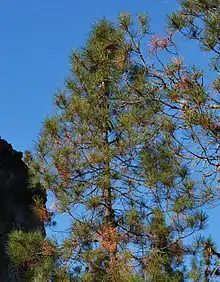Knobcone pine
The knobcone pine, Pinus attenuata (also called Pinus tuberculata[2]), is a tree that grows in mild climates on poor soils. It ranges from the mountains of southern Oregon to Baja California with the greatest concentration in northern California and the Oregon-California border.[3]
| Knobcone pine | |
|---|---|
 | |
| Scientific classification | |
| Kingdom: | Plantae |
| Clade: | Tracheophytes |
| Division: | Pinophyta |
| Class: | Pinopsida |
| Order: | Pinales |
| Family: | Pinaceae |
| Genus: | Pinus |
| Subgenus: | P. subg. Pinus |
| Section: | P. sect. Trifoliae |
| Subsection: | P. subsect. Australes |
| Species: | P. attenuata |
| Binomial name | |
| Pinus attenuata | |
 | |
Description
The knobcone pine (Pinus attenuata) crown is usually conical with a straight trunk. It reaches heights of 8–24 metres (26–79 ft).[4] However, it can be a shrub on especially poor sites. It prefers dry rocky mountain soils. The bark is smooth, flaky and gray-brown when young, becoming dark gray-red-brown and shallowly furrowed into flat scaly ridges. The twigs are red-brown and often resinous.
The leaves are in fascicles of three,[5] needle-like, yellow-green, twisted, and 9–15 cm (about 3.5–6 in) long. The cones are 8–16 cm long and clustered in whorls of three to six on the branches. The scales end in a short stout prickle. The cones remain closed for many years until a fire opens them and allows reseeding. As a result, the cones may even become embedded in the trunk as the tree grows.
 Leaves
Leaves.jpg.webp) male cones
male cones Cones
Cones Knobcone pine cone
Knobcone pine cone Plant
Plant Habitat
Habitat
Ecology
The knobcone pine (Pinus attenuata) forms nearly pure stands, however it may hybridize with bishop pine (Pinus muricata), and Monterey pine (Pinus radiata) on the coast.
In the western foothills of the Sierra Nevada, knobcone pine is often a co-dominant with blue oak (Quercus douglasii).[6]
References
- Farjon, A. (2013). "Pinus attenuata". IUCN Red List of Threatened Species. 2013: e.T42343A2974092. doi:10.2305/IUCN.UK.2013-1.RLTS.T42343A2974092.en.
- Chase, J. Smeaton (1911). "Pinus tuberculata, Also called P. attenuta (Knob-cone-pine, Scrub-pine)". Cone-bearing Trees of the California Mountains. Eytel, Carl (illustrations). Chicago: A.C. McClurg & Co. pp. 32–34. LCCN 11004975. OCLC 3477527.
- Moore, Gerry; Kershner, Bruce; Craig Tufts; Daniel Mathews; Gil Nelson; Spellenberg, Richard; Thieret, John W.; Terry Purinton; Block, Andrew (2008). National Wildlife Federation Field Guide to Trees of North America. New York: Sterling. p. 85. ISBN 978-1-4027-3875-3.
- Earle 2018.
- eNature Field Guides, 2007
- C. Michael Hogan, 2008
Further reading
- Conifer Specialist Group (1998). "Pinus attenuata". IUCN Red List of Threatened Species. 1998. Retrieved 12 May 2006.CS1 maint: ref=harv (link)
- eNature Field Guides (2007) Knobcone Pine
- Earle, Christopher J., ed. (2018). "Pinus attenuata". The Gymnosperm Database.
- C. Michael Hogan (2008) Blue Oak: Quercus douglasii, GlobalTwitcher.com, ed. Nicklas Stromberg
- Elna S. Bakker (1971). An island called California. University of California press (1972). ISBN 0-520-02159-2
External links
| Wikimedia Commons has media related to Pinus attenuata. |
- Jepson Manual treatment
- USDA Plants Profile: Pinus attenuata
- Virginia Tech Dendrology – Knobcone Pine
- Pinus attenuata in the CalPhotos Photo Database, University of California, Berkeley
